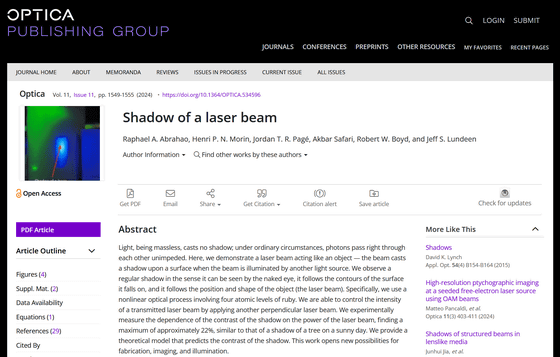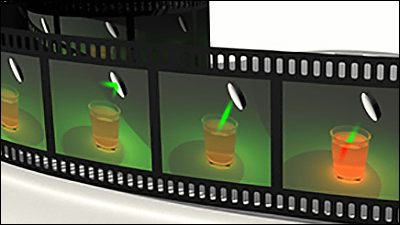Experiments confirm that light can block light and form shadows

Light usually passes through each other. For example, if two flashlights cross each other in a classroom, light has no mass, so each light continues moving forward without being affected by the other. Therefore, light does not cast a shadow on light. However, a research team from the University of Ottawa announced that they have succeeded in creating a shadow with a laser beam under special conditions.
Shadow of a laser beam

uOttawa physicists make laser cast a shadow | About us
https://www.uottawa.ca/about-us/news-all/uottawa-physicists-make-laser-cast-shadow
The researchers passed a green laser beam with a wavelength of 532 nm through a ruby crystal with side lengths of 12.0 ± 0.5 mm, designed to have an elliptical cross-section to maximize light-matter interaction. They then illuminated the green laser beam from the side with blue light of 450 nm.

As a result, they were able to create a shadow that was visible to the naked eye, and it was confirmed that it behaved in the same way as a shadow cast by a normal object. As you can see in the image below, the shadow of the laser beam appears as a black streak in the blue light.

When hit by a green laser, the chromium atoms in a ruby crystal absorb the energy of the light and enter an 'excited state.' These excited atoms immediately lose a small amount of energy and change to a special state called an 'intermediate state.' Chromium atoms in this intermediate state have the property of absorbing blue light more easily than atoms in a normal state. Therefore, where the green laser passes through, the chromium atoms enter an intermediate state and are more likely to absorb blue light, so that only those areas appear dark, that is, they are observed as shadows.
The team developed a theoretical model to predict shadow contrast and found that it was in good agreement with experimental data: Increasing the power of the green laser proportionally increased the shadow intensity, achieving a maximum contrast of 22 percent, which is roughly the same intensity as the shadow of a tree on a sunny day.

The research team suggests that this effect may also be observed in other materials such as alexandrite. 'This discovery is expected to be useful in applications such as optical switching, control of light transmittance, and lithography. This is a groundbreaking discovery that forces us to rethink the definition of shadow and provides a new understanding of the interaction of light and matter,' they say.
Related Posts:
in Science, Posted by log1i_yk





